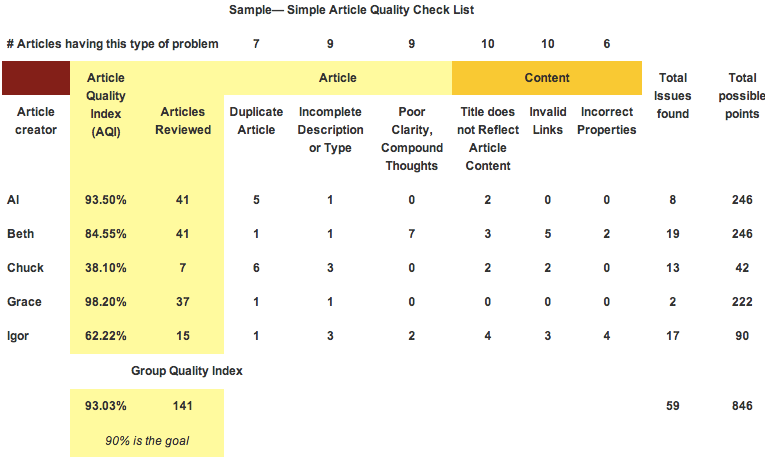Article Quality Index (AQI)
To create a knowledge environment that drives customer success, you have to deliver high-quality content. Creating and ensuring quality can be a challenge that is amplified when adding more contributors.
How do I create a basic quality standard for my content?
Some Expert customers employ complex quality standards that require very specific authoring practices. While your measure of quality may evolve to a complex level over time, it is best to start out simple.
Avoid duplicate content
Duplicate articles can fragment your content and compromise your customer experience. Additionally, duplicate content can leave your authors and content creators vulnerable to incorrect or obsolete content and requires double the amount of time to maintain.
While assessing the quality of an individual article, use Expert Search to look for similar or related articles. If you find duplicates, verify and consolidate the content.
Write clear titles
A poorly written title can eliminate both the value and adoption of an excellent article. It is important to create a title that is accurate and properly sets expectations.
Track the overall quality of your content
You do not need to measure the quality of all of your content for a helpful analysis. A sample provides adequate information that ultimately leads to higher quality content.
Pick a sample to review
Generate a list of article contributions from each Knowledge Worker. If using Expert, use the Capture Manager Report.
Narrow a sample of articles for each knowledge worker and determine a pass or fail for each of your quality measurements.
To make it easier to aggregate the data, you can enter a 1 for pass and 0 for fail.
Record your analysis in a spreadsheet with the URL of the article so you can review and fix issues later on.
Aggregate the results and share with authors
The diagram produced by the Consortium of Service Innovation showcases an analysis of 141 articles that were written by 5 authors. You can see that each author is given an article quality index (AQI) for the sample of articles that were reviewed.
This example includes six (6) quality metrics that can pass or fail. The total possible points is the number of articles reviewed multiplied by the number of quality metrics (6).

Source: Scoring the Article Quality Index from the Consortium for Service Innovation
Share the results of the analysis with your authors. Reinforce values through training and regular coaching reviews.
Additional measures to include in an AQI
After you have successfully analyzed and improved your content according to a basic quality standard, you can consider more complex quality metrics. Of course, each company's quality standards will vary based on industry, audience, material, etc.
When adding to your quality criteria, ensure it is measurable as pass or fail and that it help foster effective content.
Consider adding the following measurements to your quality criteria:
- Density - Does the article contain enough material to sufficiently address the topic?
- Completeness - Does the article address all aspects of the topic?
- Terminology - Does the article use standardized company terminology?
- Usability - Is the article appropriate for the audience?
- Accuracy - Is the article wrong or obsolete?
Use the AQI to help authors improve
Analyzing the quality of your content is not just a one-time initiative. Your content and authors will evolve, so analyze a samples of content on a scheduled cadence. It is important to share quality scores with authors to provide an opportunity for improvement.